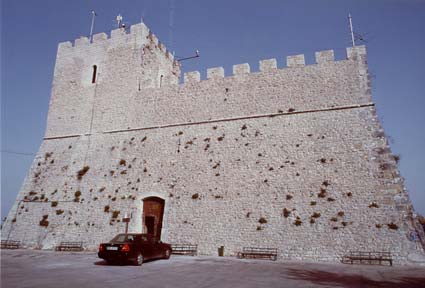![]() Castles
Castles
![]() Castle of Campobasso
Castle of Campobasso
 |
Castle
of |
The
Monforte castle is located on a high rocky spur surmounting the town (of
Longobard origin), near the intersection of two sheep-tracks of which it
controls long tracts. Erected on the site of a previous Longobard tower, it is
of Norman origin. Remains of cyclopean walls of the Samnite period have been
discovered just below it. In Norman times Campobasso became the most important
centre in the feud of the de Molisio family, and Ugone (1130) moved his
residence there. After 1237 the town became the property of the Gambatesa
family, and later of the Monforte family. Cola di Monforte (who died at the
battle of Nency) turned the castle into a seigniorial residence. In 1495 the
castle passed into the hands of Andrea di Capua and later into those of the
Gonzaga and Carafa families.
The ancient nucleus of the castle is four-sided, with a keep rising between the
northern and western sides. Four circular corner towers were subsequently added,
while the drawbridge, whose ruins are still visible, was constructed later. The
present entrance, however, is through a secondary door on the western side that
leads to the central courtyard.
The town (1460) was enlarged and surrounded by a double encircling wall and,
forty years later, by a third curtain wall. The masonry features elements of
various dimensions, well dressed and regular (especially the cornerstones), laid
on substructures that are clearly recognisable. The escarpment is very steep,
reaching to approximately 2/3 of the height and bounded by a continuous torus
frame. The events that accompanied the building of the castle and town walls are
indicated by clear wall stratigraphies and traces of the putlog holes, though
modifications and restorations (the battlements, for example) do not always
facilitate interpretation.
 |
Castle of Campobasso |